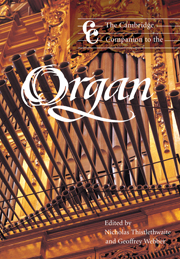2 - Organ construction
from Part I - The instrument
Published online by Cambridge University Press: 28 September 2011
Summary
The craft of organ building remains today essentially the same as it was during the development of the organ in the middle ages. Although machinery can be employed to save time and perform repetitive tasks, the core crafts of woodwork and metalwork remain at the heart of the industry. Moreover, although the metal pipes are the most distinctive feature of an organ, it is the wooden structure of the instrument that absorbs the bulk of the organ builder's time and effort. Wood remains an astonishingly useful and versatile material. Weight for weight, it is stronger than steel. Despite the alarming deforestation of the planet, a conscientious workshop can find supplies of many different species and grades of timber from renewable sources. Timber is the ideal material for custom building anything; with relatively simple equipment it can be formed into virtually any shape and adapted to almost any purpose – including, in organ building, complex air-tight components containing many moving parts.
The structure of an organ consists of a frame (usually still of solid timber, though some builders use steel) and a case. Very often, especially in small instruments or those inspired by historic precedent, the frame and case are integrated in a monocoque structure. In the Anglo-American tradition of the nineteenth and early twentieth centuries organ builders did not concern themselves much with casework – its design often left to architects and its construction to specialist joiners – but still used wood for supporting framework. Even an organ with no case, such as those built by Walter Holtkamp and others with the pipes on open display (mid-twentieth century) will still have the familiar wooden structure within.
- Type
- Chapter
- Information
- The Cambridge Companion to the Organ , pp. 18 - 30Publisher: Cambridge University PressPrint publication year: 1999



